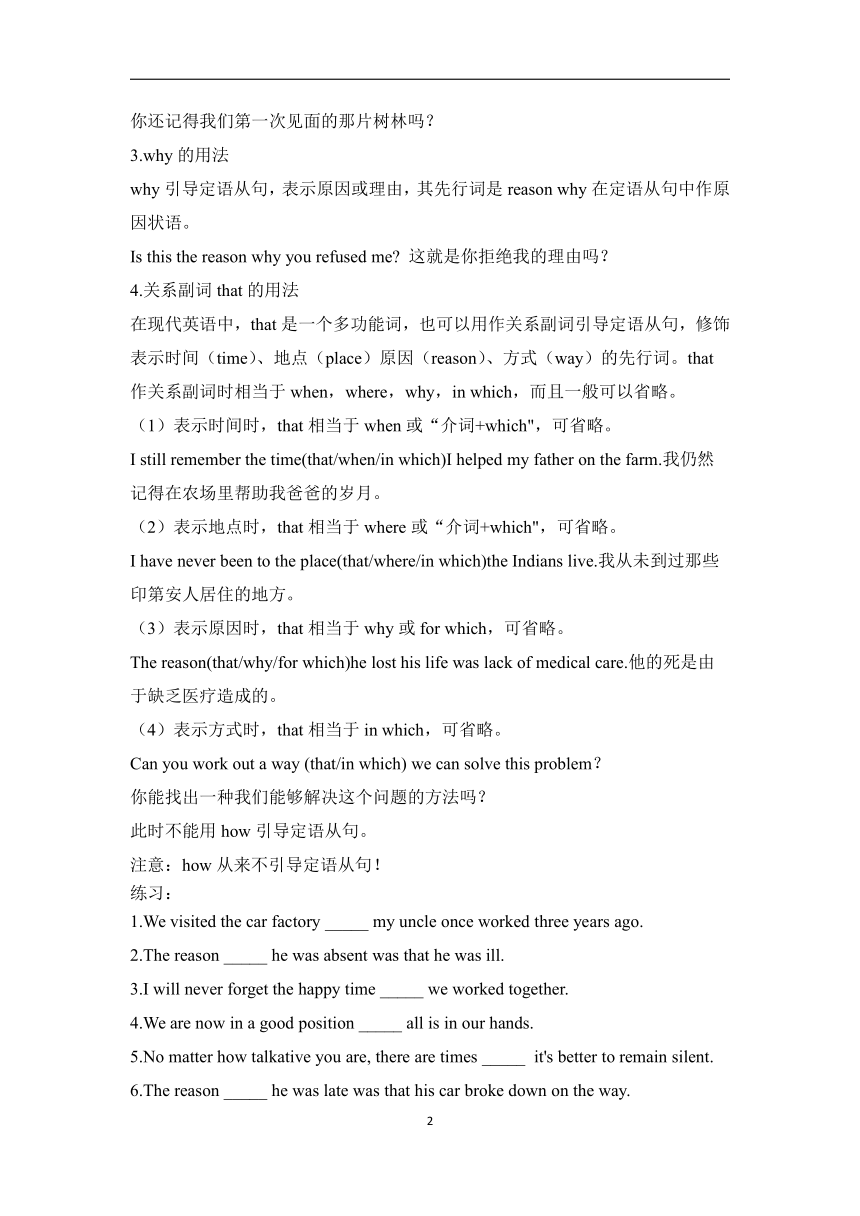外研版(2019)必修第一册Unit 5 Into the wild 大单元“四步复习法”学案(有答案)
文档属性
| 名称 | 外研版(2019)必修第一册Unit 5 Into the wild 大单元“四步复习法”学案(有答案) |

|
|
| 格式 | docx | ||
| 文件大小 | 70.7KB | ||
| 资源类型 | 教案 | ||
| 版本资源 | 外研版(2019) | ||
| 科目 | 英语 | ||
| 更新时间 | 2022-12-09 21:33:14 | ||
图片预览


文档简介
Unit 5 Into the wild—2022-2023学年高一英语外研版(2019)必修第一册大单元“四步复习法”
第一步:单元学习目标整合
1. 学生通过泛读精读能够理清文章架构,了解黑脉金斑蝶的生物习性,完成本节课的阅读
2. 学生掌握定语从句关系副词的意义和用法
3. 学生对于动物与人的关系有更加深入的体会,提高环保意识,保护动物
第二步:单元思维导图回顾知识
第三步:单元重难知识易混易错
定语从句——关系副词
1.when的用法
when引导定语从句,其先行词是表示时间的名词,如:time, morning, day, week, month, year等,when在从句中作时间状语。
I still remember the days when we swam together in the river.
我仍然记得我们在这条河中一起游泳的日子。
Do you know the date when they got married?你知道他们结婚的日期吗?
2.where的用法
where引导定语从句,其先行词往往是表示地点的名词,如place, spot, room, house, school, city 等,where在从句中作地点状语。这里说的“地点”名词包含着①具体的地点,如place, house ②抽象的地点,如case, stage, situation, position ③隐性的地点,如news, story等。
Do you still remember the woods where we first met?
你还记得我们第一次见面的那片树林吗?
3.why的用法
why引导定语从句,表示原因或理由,其先行词是reason why在定语从句中作原因状语。
Is this the reason why you refused me 这就是你拒绝我的理由吗?
4.关系副词that的用法
在现代英语中,that是一个多功能词,也可以用作关系副词引导定语从句,修饰表示时间(time)、地点(place)原因(reason)、方式(way)的先行词。that作关系副词时相当于when,where,why,in which,而且一般可以省略。
(1)表示时间时,that相当于when或“介词+which",可省略。
I still remember the time(that/when/in which)I helped my father on the farm.我仍然记得在农场里帮助我爸爸的岁月。
(2)表示地点时,that相当于where或“介词+which",可省略。
I have never been to the place(that/where/in which)the Indians live.我从未到过那些印第安人居住的地方。
(3)表示原因时,that相当于why或for which,可省略。
The reason(that/why/for which)he lost his life was lack of medical care.他的死是由于缺乏医疗造成的。
(4)表示方式时,that相当于in which,可省略。
Can you work out a way (that/in which) we can solve this problem?
你能找出一种我们能够解决这个问题的方法吗?
此时不能用how引导定语从句。
注意:how从来不引导定语从句!
练习:
1.We visited the car factory _____ my uncle once worked three years ago.
2.The reason _____ he was absent was that he was ill.
3.I will never forget the happy time _____ we worked together.
4.We are now in a good position _____ all is in our hands.
5.No matter how talkative you are, there are times _____ it's better to remain silent.
6.The reason _____ he was late was that his car broke down on the way.
7.He wanted to know the reason _____ I told the manager for my mistake.
答案:1.答案:where
解析:考查定语从句。句意:我们参观了我叔叔三年前曾工作过的那个汽车厂。本空引导定语从句,修饰名词car factory,本空在从句中作地点状语,故应用关系副词where。
2.答案:why
解析:句意: 他缺席的原因是他生病了。先行词为reason, 表原因, 且从句不缺主语和宾语, 故设空处应填关系副词why, 在定语从句中作原因状语。
3.答案:when
解析:句意: 我将永远不会忘记我们在一起工作的美好时光。先行词是time, 从句不缺主语, 且work是不及物动词, 其后不用接宾语, 故设空处应填when, 在定语从句中作时间状语。
4.答案:where
解析:考查定语从句。句意:我们现在处于一个有利的形势,一切尽在我们掌握之中。本空引导定语从句,修饰表抽象地点的名词position,本空在从句中作地点状语,故应用关系副词where。
5.答案:when
解析:考查定语从句。句意:不管你是多么健谈的人,有时候还是保持沉默比较好。本空引导定语从句,修饰名词times,本空在从句中作时间状语,故应用关系副词when。
6.答案:why
解析:考查定语从句。句意:他迟到的原因是他的车在路上抛锚了。本空引导定语从句,修饰名词reason,本空在从句中作原因状语,故应用关系副词why。
7.答案:that/ which
解析:考查定语从句。句意:他想知道我为我的错误向经理说的原因。本空引导定语从句,修饰名词reason,本空在从句中作told的宾语,故应用关系代词that或which。
第四步:单元核心素养对接高考
语法填空
Beijing opera or Peking opera is a form of Chinese opera ①_____(combine) music, vocal performances, dance and so on. It ②_____(arise) in the late 18th century and became ③_____(full) developed and recognized by the mid-19th century. The form was extremely popular in ④_____ Qing Dynasty court and has come to be regarded as one of the ⑤_____(culture) treasures of China. Major performance troupes (剧团,戏班子) are based in Beijing and Tianjin in the north, and Shanghai in the south. Also ⑥_____(preserve) in Taiwan, the art form is still of great importance to people there.
⑦_____(perform) of Peking opera use the skills of speech, song, dance, and combat in movements that are symbolic and suggestive. Above all else, the skill of performers ⑧_____(evaluate) according to the beauty of their movements. The music of Beijing opera can be divided ⑨_____ the Xipi and Erhuang styles. The repertoire (全部曲目) of Beijing opera includes over 1,400 works, ⑩_____ characters are based on Chinese history, folklore, and, increasingly, contemporary life.
答案:
①combining ②arose ③fully ④the ⑤cultural ⑥preserved ⑦Performers ⑧is evaluated ⑨into ⑩whose/where
解析:①考查非谓语动词。根据谓语动词is以及空处前后没有连词可知, 空处应填非谓语动词。因opera与combine之间是主动关系,所以空处应用动词-ing形式作定语:
②考查时态。京剧出现于18世纪后期,在19世纪中期得到了充分的发展和认同。根据时间状语"in the late 18th century"可知,空处应用一般过去时。
③考查副词。分析句子结构可知,空处修饰动词developed,故应用副词作状语。
④考查冠词。这种表演形式在清代宫廷里非常受欢迎, 而且开始被认为是一种中华文化瑰宝。专有名词前面要用定冠词表示特指。
⑤考查形容词。分析句子结构可知,此处用形容词修饰名词treasures。
⑥考查非谓语动词。preserve与其逻辑主语the art form是被动关系,所以用动词-ed形式作状语。
⑦考查名词。分析句子结构可知, 空处作主语;再结合谓语动词use可知,此处应用名词的复数形式。
⑧考查时态和语态。分析句子结构可知,主语the skill of performers是谓语动词表示的动作的袭受者,且表示客观事实,所以用一般现在时的被动式。
⑨考查介词。京剧的音乐可以分为西皮和二黄两种风格。divide...into...为固定搭配,意为"把......分为......"。
⑩考查定语从句。空处引导定语从句,修饰先行词works,在定语从句中作characters的定语;也可以将works理解为抽象的地点,空处在定语从句中作状语。所以用whose或where引导定语从句。
2
第一步:单元学习目标整合
1. 学生通过泛读精读能够理清文章架构,了解黑脉金斑蝶的生物习性,完成本节课的阅读
2. 学生掌握定语从句关系副词的意义和用法
3. 学生对于动物与人的关系有更加深入的体会,提高环保意识,保护动物
第二步:单元思维导图回顾知识
第三步:单元重难知识易混易错
定语从句——关系副词
1.when的用法
when引导定语从句,其先行词是表示时间的名词,如:time, morning, day, week, month, year等,when在从句中作时间状语。
I still remember the days when we swam together in the river.
我仍然记得我们在这条河中一起游泳的日子。
Do you know the date when they got married?你知道他们结婚的日期吗?
2.where的用法
where引导定语从句,其先行词往往是表示地点的名词,如place, spot, room, house, school, city 等,where在从句中作地点状语。这里说的“地点”名词包含着①具体的地点,如place, house ②抽象的地点,如case, stage, situation, position ③隐性的地点,如news, story等。
Do you still remember the woods where we first met?
你还记得我们第一次见面的那片树林吗?
3.why的用法
why引导定语从句,表示原因或理由,其先行词是reason why在定语从句中作原因状语。
Is this the reason why you refused me 这就是你拒绝我的理由吗?
4.关系副词that的用法
在现代英语中,that是一个多功能词,也可以用作关系副词引导定语从句,修饰表示时间(time)、地点(place)原因(reason)、方式(way)的先行词。that作关系副词时相当于when,where,why,in which,而且一般可以省略。
(1)表示时间时,that相当于when或“介词+which",可省略。
I still remember the time(that/when/in which)I helped my father on the farm.我仍然记得在农场里帮助我爸爸的岁月。
(2)表示地点时,that相当于where或“介词+which",可省略。
I have never been to the place(that/where/in which)the Indians live.我从未到过那些印第安人居住的地方。
(3)表示原因时,that相当于why或for which,可省略。
The reason(that/why/for which)he lost his life was lack of medical care.他的死是由于缺乏医疗造成的。
(4)表示方式时,that相当于in which,可省略。
Can you work out a way (that/in which) we can solve this problem?
你能找出一种我们能够解决这个问题的方法吗?
此时不能用how引导定语从句。
注意:how从来不引导定语从句!
练习:
1.We visited the car factory _____ my uncle once worked three years ago.
2.The reason _____ he was absent was that he was ill.
3.I will never forget the happy time _____ we worked together.
4.We are now in a good position _____ all is in our hands.
5.No matter how talkative you are, there are times _____ it's better to remain silent.
6.The reason _____ he was late was that his car broke down on the way.
7.He wanted to know the reason _____ I told the manager for my mistake.
答案:1.答案:where
解析:考查定语从句。句意:我们参观了我叔叔三年前曾工作过的那个汽车厂。本空引导定语从句,修饰名词car factory,本空在从句中作地点状语,故应用关系副词where。
2.答案:why
解析:句意: 他缺席的原因是他生病了。先行词为reason, 表原因, 且从句不缺主语和宾语, 故设空处应填关系副词why, 在定语从句中作原因状语。
3.答案:when
解析:句意: 我将永远不会忘记我们在一起工作的美好时光。先行词是time, 从句不缺主语, 且work是不及物动词, 其后不用接宾语, 故设空处应填when, 在定语从句中作时间状语。
4.答案:where
解析:考查定语从句。句意:我们现在处于一个有利的形势,一切尽在我们掌握之中。本空引导定语从句,修饰表抽象地点的名词position,本空在从句中作地点状语,故应用关系副词where。
5.答案:when
解析:考查定语从句。句意:不管你是多么健谈的人,有时候还是保持沉默比较好。本空引导定语从句,修饰名词times,本空在从句中作时间状语,故应用关系副词when。
6.答案:why
解析:考查定语从句。句意:他迟到的原因是他的车在路上抛锚了。本空引导定语从句,修饰名词reason,本空在从句中作原因状语,故应用关系副词why。
7.答案:that/ which
解析:考查定语从句。句意:他想知道我为我的错误向经理说的原因。本空引导定语从句,修饰名词reason,本空在从句中作told的宾语,故应用关系代词that或which。
第四步:单元核心素养对接高考
语法填空
Beijing opera or Peking opera is a form of Chinese opera ①_____(combine) music, vocal performances, dance and so on. It ②_____(arise) in the late 18th century and became ③_____(full) developed and recognized by the mid-19th century. The form was extremely popular in ④_____ Qing Dynasty court and has come to be regarded as one of the ⑤_____(culture) treasures of China. Major performance troupes (剧团,戏班子) are based in Beijing and Tianjin in the north, and Shanghai in the south. Also ⑥_____(preserve) in Taiwan, the art form is still of great importance to people there.
⑦_____(perform) of Peking opera use the skills of speech, song, dance, and combat in movements that are symbolic and suggestive. Above all else, the skill of performers ⑧_____(evaluate) according to the beauty of their movements. The music of Beijing opera can be divided ⑨_____ the Xipi and Erhuang styles. The repertoire (全部曲目) of Beijing opera includes over 1,400 works, ⑩_____ characters are based on Chinese history, folklore, and, increasingly, contemporary life.
答案:
①combining ②arose ③fully ④the ⑤cultural ⑥preserved ⑦Performers ⑧is evaluated ⑨into ⑩whose/where
解析:①考查非谓语动词。根据谓语动词is以及空处前后没有连词可知, 空处应填非谓语动词。因opera与combine之间是主动关系,所以空处应用动词-ing形式作定语:
②考查时态。京剧出现于18世纪后期,在19世纪中期得到了充分的发展和认同。根据时间状语"in the late 18th century"可知,空处应用一般过去时。
③考查副词。分析句子结构可知,空处修饰动词developed,故应用副词作状语。
④考查冠词。这种表演形式在清代宫廷里非常受欢迎, 而且开始被认为是一种中华文化瑰宝。专有名词前面要用定冠词表示特指。
⑤考查形容词。分析句子结构可知,此处用形容词修饰名词treasures。
⑥考查非谓语动词。preserve与其逻辑主语the art form是被动关系,所以用动词-ed形式作状语。
⑦考查名词。分析句子结构可知, 空处作主语;再结合谓语动词use可知,此处应用名词的复数形式。
⑧考查时态和语态。分析句子结构可知,主语the skill of performers是谓语动词表示的动作的袭受者,且表示客观事实,所以用一般现在时的被动式。
⑨考查介词。京剧的音乐可以分为西皮和二黄两种风格。divide...into...为固定搭配,意为"把......分为......"。
⑩考查定语从句。空处引导定语从句,修饰先行词works,在定语从句中作characters的定语;也可以将works理解为抽象的地点,空处在定语从句中作状语。所以用whose或where引导定语从句。
2
同课章节目录
